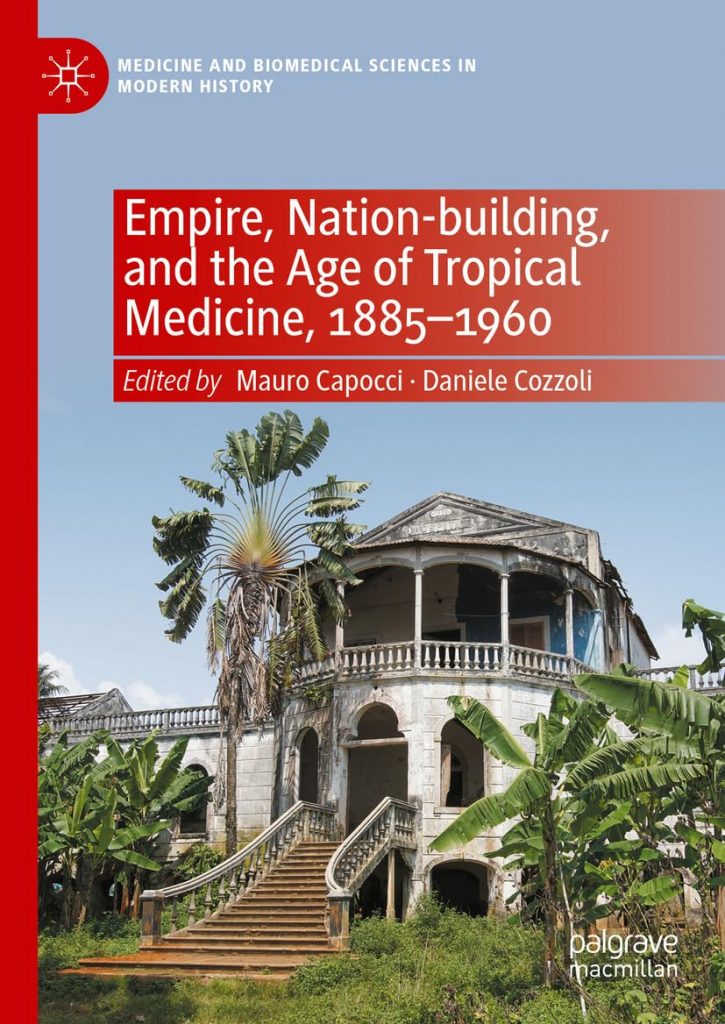Much has been said about the racist character of the ‘War on Drugs’. To explore this character more fully I take a look at drug policies in the Dutch colonial empire. In the second half of the nineteenth century, the Dutch started to modernize their empire and attempted to build ‘modern colonial states’ in their territories in the East Indies (present-day Indonesia) and West Indies (Suriname/Dutch Guiana, and the Dutch Caribbean islands). The endemic presence of certain diseases and behaviours was felt to threaten the colonial project. Colonial medicine played a key role in managing these ‘problems’. My chapter in the recently published volume Empire, Nation-Building, and the Age of Tropical Medicine, 1885-1960 investigates and compares polices and attitudes around two very different cases: leprosy and drug abuse. Colonial policies towards these cases show remarkable similarities: in both, a translation took place of an international global ‘colonial framing’. Non-white leprosy sufferers and drug users from different ethnic and cultural backgrounds (African, Indian, Chinese, Indonesian) were constructed by colonial medicine as being passive, undisciplined, disturbing labour efficiency, and threatening to contaminate whites (through sexual contacts and other means) or to seduce them in ‘going native’. Colonial strategies against these dangers included compulsory segregation of leprosy sufferers and the first prohibitive drug laws in Dutch territories. These policies created a legacy of a colonial cultural archive that is still around today.
Tag Archives: history of drugs
Drugssmokkelland: hoe Nederland een paradijs voor drugssmokkel werd. Een Nederlandstalige publieksversie
De resultaten van mijn onderzoek naar de geschiedenis van de drugssmokkel in Nederland zijn in eerste instantie vastgelegd in een academische Engelstalige versie voor Manchester University Press. Sinds die publicatie kreeg ik steeds meer geluiden te horen dat het jammer was dat een boek over zo’n actueel en maatschappelijk relevant onderwerp niet heel toegankelijk was voor de niet-academi-sche Nederlandse lezers en lezeressen. Bovendien eindigt het boek rond 1995, terwijl we ondertussen alweer een kwart eeuw verder zijn. Ik heb daarom, na overleg met en met instemming van de Engelse uitgever, een nieuwe versie geschreven bestemd voor de Nederlandstalige publieksmarkt. Op 14 oktober verschijnt deze versie bij de Walburg Pers.
Dit is geen directe vertaling van het Engelse boek. In vergelijking met de Engelstalige rapportage is enerzijds de tekst met bevindingen met ongeveer de helft teruggebracht. Theoretische en historiografische gedeeltes zijn tot een minimum teruggebracht. Anderzijds is er nieuw materiaal toegevoegd: nieuwe verhalen over de drugssmokkel van de afgelopen eeuw die illustratief zijn voor het functioneren ervan, en een heel nieuw hoofdstuk over de situatie vandaag de dag en de ontwikkelingen in de afgelopen vijfentwintig jaar. Leidraad voor het boek is een nieuwe metafoor voor het functioneren van de drugssmokkel: niet de Godfathers en Scarfaces die zulke geliefde rolmodellen zijn voor jonge would-be criminelen, maar Marten Toonders stripfiguren Bul Super en Hiep Hieper.
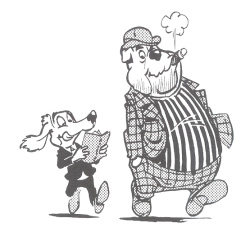
Bul Super en Hiep Hieper debuteerden in 1944 en vertonen duidelijke overeenkomsten met de onderwereldfiguren uit Toonders tijd. Het zijn opportunistische vrije jongens zonder moraal, steeds op zoek naar nieuwe en meestal illegale activiteiten om geld te verdienen. Super wordt door Hieper de baas genoemd, hetgeen slechts betekent dat de eerste de laatste domineert door zijn persoonlijkheid en fysieke kracht. Super en Hieper zijn individualisten. Tegelijk zijn ze sociaal en cultureel ingebed in de onderwereld van hun stad Rommeldam: door hun sociale contacten en ontmoetingsplekken, en door een gedeelde culturele kijk op de wereld. De beide ‘zakenlieden’ hebben een uitgebreid netwerk van gelijkgestemde onderwereldfiguren in de Rommeldamse kroegen en stegen. Regelmatig slagen ze er ook in tijdelijke verbonden te sluiten met de Rommeldamse bovenwereld. Maar er is geen sprake van een georganiseerde misdaad, slechts van wisselende samenwerkingsverbanden. Alleen in 1966 lijkt Super een stap verder te kunnen gaan als hij in het verhaal Bombom de Geweldige de onderwereld van Rommeldam verenigt in de Zwarte Gruwel, een bende van roofovervallers en ontvoerders, maar het succes ervan is (zoals bij de meeste van zijn ondernemingen) slechts van korte duur.
Bul Super en Hiep Hieper, hoe fictief hun bestaan ook is, zijn schoolvoorbeelden van de criminele anarchie die de Nederlandse drugssmokkel de afgelopen eeuw heeft gekenmerkt.
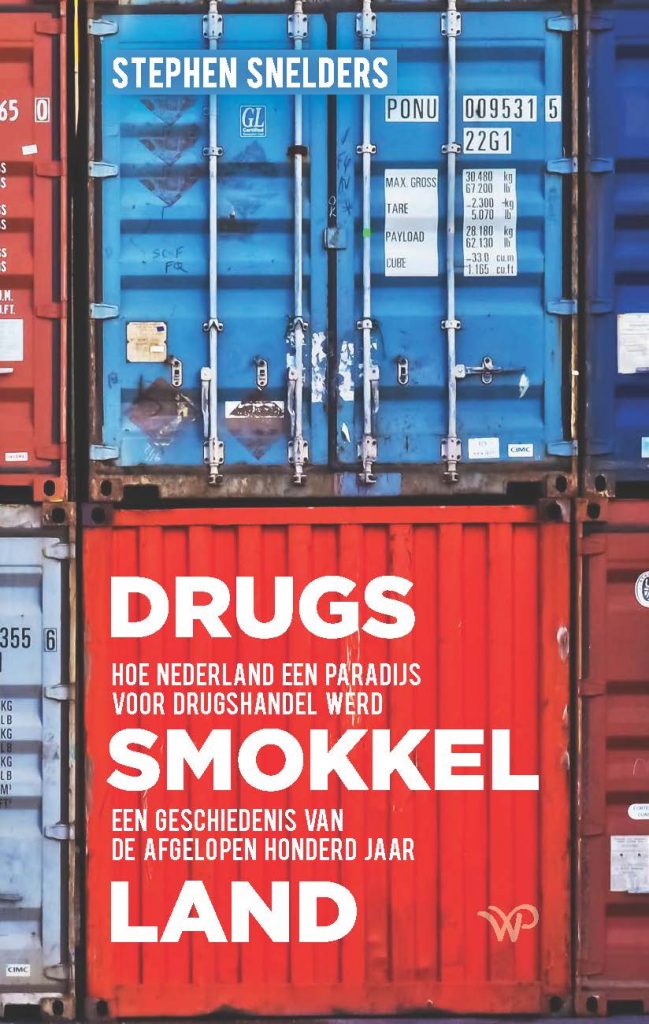
New book on drug smuggling and the Netherlands out in 2020
The past years I have been working on a new history of drug smuggling and the Netherlands in the twentieth century, in the context of the project The Imperative of Regulation funded by NWO, the Dutch Organization for Scientific Research. I have now come to an agreement with Manchester University Press to publish a book on the subject in the course of 2020.
The book intends to show how and why the Netherlands developed in the course of the twentieth century into a central hub of the international illegal drug trade. The book details the responses of smugglers to the state regulation of the market and the increasing demand of consumers, and develops a model of ‘criminal anarchy’ to explain the successes of the illegal drug trade. By using a long-term historical perspective on ‘the Dutch experience’ the book further elaborates and modifies the criminological concept of ‘disorganized crime’. It situates ‘criminal anarchy’ within Dutch society: historically, socially and culturally embedded in both native and migrant communities with their own historical traditions.
Historical investigation leads to the conclusion that when drug policy focuses on the fight against the supply side law enforcement will win the occasional battle, but is unlikely to win the war against drugs. Rather the reverse is the case: fighting the supply side only stimulates the proliferation characteristic of criminal anarchy. Consumer demand is uncompromising when there is no access to an alternative legal supply of drugs.
I will unfold the patterns of criminal anarchy narrating and discussing among others smuggler-users, Sixties idealists turned smugglers, and criminal entrepreneurs. The book details the activities of native Dutch, Chinese, Greek, and other smugglers before and after the Second World War; the rise of the Dutch cannabis trade and cultivation and its global connections; the Chinese, Turkish and Kurdish heroin trade; the Colombian cocaine syndicates; and the rise of the synthetic drug industry and the subversion of the state by Dutch criminal networks in the south and elsewhere in the country.
Drugs in het Derde Rijk
De Duitse schrijver Norman Ohler heeft in het voetspoor van schrijvers en historici als Werner Pieper, Peter Steinkamp en als ik zo onbescheiden mag zijn mijzelf het drugsgebruik in Nazi-Duitsland verder uitgespit. Zijn boek Der totale Rausch werd in Duitsland een bestseller. In september zal een Nederlandse vertaling verschijnen bij uitgeverij Luiting-Sijthoff in Amsterdam. Op verzoek van de uitgever heb ik voor deze vertaling een nawoord geschreven, waarin ik de situatie rond drugs in Nederland onder de Duitse bezetting bespreek. (Zie ook mijn post op de Alcohol and Drugs History Society-website.)
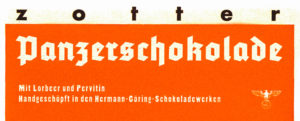
The Oriental Framing of Drug Abuse
THE ORIENTAL FRAMING OF DRUG ABUSE AND THE FEAR OF ‘GOING NATIVE’:
DRUG ADDICTS AND LEPROSY SUFFERERS IN THE AGE OF IMPERIALISM – A COMPARATIVE PERSPECTIVE
PAPER CONFERENCE ‘UNDER CONTROL – ALCOHOL AND DRUG REGULATION, PAST AND PRESENT’, LONDON 21-23 JUNE 2013
Stephen Snelders
1.
It is now the final paper and I guess everybody is longing for a well-deserved drink. I will therefore not delve into another detailed case study. On the contrary, after hearing all the interesting papers presented in our Addiction in Asia panels (and thanks to Jim Mills for organizing and stimulating these panels), I want to ask some questions about the relationship between addiction in Asia and the dynamics of drug control on a wider scale: I am interested here in the relationship between addiction in Asia and addiction in the Empires.
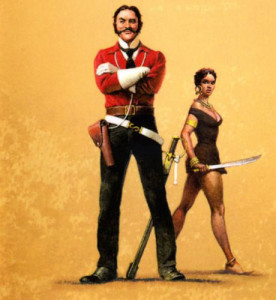
Much has been made by authors as Marianne Valverde and also by myself in the past of the relationship between the (negative) image of the drug addict and the rise of the nation-state in the 19th century. The drug abuser, who relinquishes control over his own will, is the exact antithesis of the responsible democratic citizen that is supposed to be the cornerstone of the democratic project. This analysis makes sense as far as it goes, but here I will suggest that we can also see something different and perhaps more fundamental if we take an imperial perspective. In this paper I will argue that it is not so much the rise of the liberal state that problematizes the use of drugs, but the fears that went together with the extension of imperial dominion over other races.
I will try to argue that our present-day framing of drug use cannot be understood without taking into account the imperialist and global context of 19th-century society. In fact, as I will argue, the process of the framing of drug abuse can be traced back to developments in 18th-century colonial society.
I will try to show this by making a comparison with another process of framing that took place at the onset of imperialism: that of the leprosy sufferer. You might be surprised to hear me make this connection, but is not a new one. In the 1960s, when a large drug-using culture expanded and prohibition became a contested issue, vocal proponents of this drug culture formulated the notion of drug users as victims of society, criminalized and stigmatized. Drug users were, in the sociological theory of Howard Becker, made into outsiders. Users compared themselves to the persecuted medieval witches and lepers. In his Histoire de la folie (Madness and Civilization, 1961). Foucault suggested that the stigma of lepers survived long after leprosy itself had become extinct in Europe and the leprosy asylums had emptied. ‘The values and images connected to the leprosy sufferer continued to exist.’ The games of exclusion were played again, but now with the insane. This analysis has been much discussed and debated. It is not my concern here to enter this discussion. I am not interested here in an exercise in Foucauldian discourse. I am interested however, in a much clearer connection: between the values and images around drug users on the one hand, and leprosy sufferers on the other, in the 19th century.
2.
There is a fascinating similarity in the cultural production of the images of the drug user and of the leprosy sufferer in the 19th century. In both cases, public and medical understanding of a problem mingles and confuses health and social issues, resulting in what I will call an oriental framing, a framing that is intimately bound up with the rise and development of imperialism. A comparison between the oriental framing of drug abuse and that of leprosy is enlightening in this respect. In making this comparison I will draw together the published literature on the histories of drugs and of leprosy.
To start with, we immediately perceive a similarity when reading this quote of leprosy historian Zachary Gussow. He made the important observation that a disease (or a disorder) in itself is perceived as socially threatening. when: ‘The condition must threaten a class of citizens, a way of life; it must arouse public concern; above all, it must give rise to action. It must become a social problem.’
The development of drug use as a social problem has been described and analyzed in the past. To memorize, David Courtwright has described the following development of the public image of drug users in the United States: in the second half of the 19th century the image of the user is still a far cry from our modern perception of the socially degraded junkie. The ‘dominant addict type’ in this period is a woman of middle age from the middle or higher classes. She is dependent on morphine or opium that she takes on the prescription of the family doctor. She looks rather like the typical housewife on barbiturates as depicted in the Rolling Stones’ Mother’s Little Helper.
According to Courtwright after around 1895 this image drastically changes. Drug use becomes more and more associated with non-medical use: at first smoked opium is seen as the most important drug of abuse. At the time of the First World War this has shifted to morphine, and by the 1930s to heroine. On the eve of the Second World War the ‘dominant addict type’ has changed into the ‘nonmedical addict’: the junkie who gets his drug in all possible ways. Next to opium cocaine, sniffed and not injected as in medical use, becomes the number two ‘diabolized’ drug. From 1900 onwards the image of the cocaine fiend develops, an image with strong racist overtones: the cocaine fiend in the South is often a black American sexually threatening white women. Needless to say, the development of the public image of the junkie goes hand in hand with increasing drug legislation. In the United States drug use becomes associated with deviant groups at the borders of society, groups with an often as inferior perceived biological make-up: Afro-Americans, Latin Americans, and so on.
3.
So far so good. But the cultural production of an Orientalized image of the drug abuser starts much earlier, in fact well before drug abuse came to be seen as a significant social problem, and well before the age of imperialism. Let’s get back to Thomas de Quincey and his Confessions of an English Opium Eater (1821) – maybe the earliest and certainly the most well-known example of the oriental framing. As Alethea Hayer wrote about De Quincey, whose Confessions of an opium-eater were first published in1821: he did not break any law, public opinion was not against him or even focused on him, and supplies of his drug were cheap and easily available. It was De Quincey himself who produced a cultural image of his drug use as a threat from oriental regions. In his 1991 study of De Quincey John Barrell claims that De Quincey was ‘terrorised by the fear of an unending and interlinked chains of infections from the east, which threatened to enter his system and to overthrow it, leaving him visibly and permanently ‘compromised’ and orientalised. The Orient here is actually an undifferentiated mixture of Chinese, Indian, Egyptian and other images, forming in the words of Barrell one ‘pathological identity’. ‘The Orient [for De Quincey] is the place of a malign, a luxuriant or virulent productivity, a breeding ground of images of the non-human, or of the no less terrifyingly half-human, which cannot be exterminated, except at the cost of exterminating one’s self, and which cannot be kept back beyond the various Maginot lines […] that De Quincey attempts to defend against the ‘horrid enemy’ from Asia.’ To quote De Quincey himself: ‘I was kissed, with cancerous kisses, by crocodiles; and laid, confounded with all unutterable slimy things, amongst reeds and Nilotic mud.’
As Alan Bewell points out in his Romanticism and Colonial Disease, this threat receives a powerful expression in De Quincey’s account of the Malay that one day knocks on his door. Not only is the Malay a fellow opium-eater and in this respect despite his cultural otherness similar to De Quincey himself, he is also a sexual threat to the white race, personified in his encounter with a beautiful young English girl who had never before seen anything Asian.
However, unlike the orientalized image suggest De Quincey himself was actually far from passive because of his opium use. On the contrary, he describes how, high on opium, he roams the streets of London on Saturday night, relishing the spectacles of the working classes enjoying their time-off. Only later in his life does he appear to succumb to the inactivity and torpor of the opium-eater. De Quincey himself was never an outcast of society.
His orlental framing of his drug use, with the associations of loss of self-control and of identity, confounded in a slimy pit, actually points as much to the past as to the future. It goes back to much earlier medical and social fears that prop up in the European colonial empires. The European who goes native loses the very core-essence of his whiteness and becomes a non-European itself. This is perceived as a a danger for European rule over other races in itself.
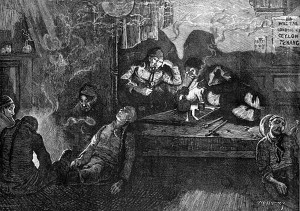
4.
As Bewell shows and as every student of early modern colonialism and colonial medicine immediately recognizes, the drug problem of De Quincey is not a national English, but an imperial problem. The changing disease-environment and the close proximity to slaves of African descent prompted inquiries in health and disease of the non-white population in the Caribbean as early as the 18th century. By the later eighteenth century the topic of what feminist historian Londa Schiebinger has called the ‘anatomy of difference’ between races was widely debated among the scientists and savants of Europe. Explanations for these ‘differences’ ranged between environmentalism and hereditarianism, including combinations of both. While in Europe this was of more theoretical concern, in the colonies the question of why and to what extent different races were prey to different diseases was of eminently practical concern. As Sean Quinian writes in his study of the French colonies, the ultimate distinction between the races was located in the amount of self-control a male European could exert, in order to regulate his functioning in accordance with the environment. ‘In a sense, the diseased body became the ultimate signifier of not just the pathological milieu but the total lack of physical self-control exercised by the European individual’, writes Quinian.
It is this racial stereotyping that in the 19th century gets transferred to the yellow and brown races of the Orient. De Quincey points the way. By 1870, the association between drugs, passivity, dirtiness, and race, is exemplified by Dickens in his unfinished The Mystery of Edward Drood. Interestingly enough, this is before the Age of Imperialism really gets into full swing. That drug use could be a habit of an active man, such as Alexandre Dumas’ Count of Monte Cristo, becomes a notion relegated to drug-using subcultures. Even Sherlock Holmes’ drug use is now a matter of medical concern. By the end of the 19th century, as Howard Padwa in his recent study Social Poison suggests, the association of opium use and Chinese is established as threatening the empire.
5.
As is the association with leprosy. The notion of leprosy as a perceived ‘danger to the empire’ is mostly associated with the end of the 19h century, the Age of Imperialism and the onset of scientific racism and Social Darwinism. At that time leprosy came to be regarded as an ‘imperial disease’ moving throughout the European colonial empires through migration of people and circulation of goods, and affecting white people in the process. In 1989 Zachary Gussow concluded in his study of American leprosy politics in an international context:
‘(…) by the nineteenth century [leprosy] had reappeared and by the end of the century had caused Western nations to panic. During the period of nineteenth-century imperialism, the disease was discovered to be hyperendemic in those parts of the world that western nations were annexing and colonizing. The discovery of leprosy in the colonial world, and the excitement in the 1860s generated by the announcement of an epidemic in Hawaii, revived Western concerns about a disease that otherwise remained but a memory.’
The ex-medical officer of the Confederacy, Joseph Jones, writes in 1887:
‘At the present day Louisiana is threatened with an influx of Chinese and Malays, with filth, rice and leprous diseases [,,,] patriots should contemplate with dread the overflew of their country by the unprincipled, vicious and leprous hordes of Africa.’
There are by 1893 355 Chinese sufferers in Louisiana, of which 300 in New Orleans. Leprosy, as opium use, seems to threaten the United States and in the 1880s measures are taken to prevent leprous Chinese coming into the country. What’s more, attention is again directed to white leprosy sufferers, who before 1880 seemed to have more or less been left in peace, and doctors go actively in search for the disease. In 1917 Congress decides on the creation of a national leprosarium to isolate the sufferers, not long after the passing of the Harrison Act against drug use. Other Anglophone countries as Australia and New Zealand, as well as Hawaii took their own measures against the Chinese immigrants from the 1880s onwards. The physician James Cantlie suggested in a 1897 report that all migrants should be examined, and sufferers expelled.
Gussow relates the ‘rediscovery’ and renewed fears of leprosy to anxieties about Chinese immigration and the endangerment of ‘American-ness’. But interestingly enough, similar processes were at work in China itself. Activists struggling for a more powerful China and the end of the ‘feudal’ Manchu dynasty had casted opium use as a vicious habit brought in by the western barbarians to undermine the celestial empire (an interpretation that is rejected by Dikötter et al in their history of Chinese drug culture). In China the anti-opium offensive connected to the Opium Wars and later were related to the rise of bourgeoisie and nationalism. Opium poisoned the nation, especially after the lost war against Japan of 1895. In a similar vein, to Chinese nationalists and the revolutionaries of 1912 leprosy became a sign of the undisciplined body, a matter of shame for China, necessitating isolation of sufferers and public health policies.
6.
Conclusion
The framing of drug abuse and leprosy as socially threatening diseases was not solely a matter of local developments. Imperialism meant the need for more control of geoographical territories as well as of global migration movements. Racial framing, connecting the diseases with yellow and black ‘inferior races’ was a central part of the process of understanding both conditions, but also of stigmatizing drug users and leprosy sufferers. Where around 1800 one could take his drugs rather publicly, or mingle as leprosy sufferer in most regions around the globe with other people, by 1900 this had become impossible and suspect. The opium user of 1900 was no longer the active Count of Monte Cristo, taking a rest on his way from one part of Europe to another, or De Quincey touring the streets of London in psycho-geographical research, but the languid and passive degenerate of the London opium shed.
Of course, different nations had different timing and styling of these developments. Can we understand these differentiations better by taking a look at the imperial contexts?
The Blue Lotus Revisited
THE BLUE LOTUS REVISITED: PUBLIC PERCEPTIONS OF DRUG USE IN THE DUTCH EMPIRE, c. 1900 – 1942
Stephen Snelders & Toine Pieters
Paper Drugs and drink in Asia: New perspectives from History
June 22-24, 2012, Shanghai University, China
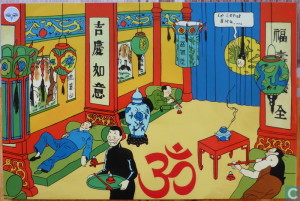
Introduction
The Dutch colonial empire was in the first half of the 20th century one of the most important manufacturers and distributors of psychoactive drugs, as is well known: of smoked opium in the Dutch East Indies, and of coca and cocaine on a worldwide scale. Dutch drug policies of that period, in the colonies, in the Netherlands themselves, and in international organizations and negotiations, had to balance between a number of factors and (seemingly contradictory) motives: economic motives, ethical concerns about the harmful effects of drug use, and political demands to adjust to international drug regulation regimes. Historians have studied all of these factors up to a certain degree. Little is known about another important factor: perceptions and sentiments concerning drug use, including drug policies, production and trade, among the public both in the Netherlands and in the Dutch colonies.
How did the inhabitants of the Dutch colonial empire, from various social classes and cultures (Dutch, Malaysian, Chinese, Dayak etc.) perceive and feel about the use of different drugs? To what extent was it seen as problematic? Did perceptions and sentiments change in the interwar period up to the Japanese invasion of the East Indies? And how did public opinions influence policies in the homeland as well as in the colonies?
Looked upon from a bird’s eye view, the Dutch empire in the interwar period shows many contradictions in its national and colonial drug policies. If we follow the most authoritative and extensively researched study on drug policies in the home land, we notice that from the Shanghai conference of 1909 onwards the Netherlands follow (albeit sometimes hesitantly and unwillingly) the lead of the United States and the League of Nations in constructing and implementing a regime of increasing prohibition of production, distribution and possession of drugs. This in spite of the non-existence until after the Second World War of a drug problem in the Netherlands itself. How is this rather docile position of Dutch governments, continuing until the 1970s, to be explained from the perspective of internal politics? At the same time policies in the Dutch colonial territories in the East Indies were remarkably divergent. Where in the home country strict policies were enforced against uses of opiates and cocaine, opium was imported in the Dutch East Indies by the colonial states, refined to smoked opium in a state factory, and distributed to the subjugated population using a system that was a remarkable predecessor of the famous ‘coffee-shop’ policies of the past 35 years. At the same time coca became a successful agricultural crop exported to Europe, in particular Germany and the Netherlands itself, for the legal production of (medicinal) cocaine. How are these paradoxes to be explained? And how at the time did Dutch citizens perceive these paradoxes – if they were perceived at all?
One way of finding out more about these perceptions is by an analysis of newspapers. We are of course very aware that these do not necessarily represent the perceptions, opinions and sentiments of every segment of the Dutch public or of non-conformist individuals, and are as much aware that public opinion is only one among many factors influencing the construction and implementation of drug policies. Nonetheless, an analysis of the daily press in the different parts of the Dutch empire gives us some insight into the dynamics and development of public opinion. Were drug policies in the metropolis as well as in the colonies uncritically accepted in the whole range of the daily press? Or can we detect critical voices? When, to what extent, how and why was drug use seen as a major problem? Was it seen as a problem of individual citizens, of public health and/or of public order and crime control? Were differentiations made among drug users respective of class, gender or cultural and ethnic background? And what is maybe the most interesting question: was there any perception of the paradox of both prohibiting drugs and making money by selling them?
This paper will present preliminary results of a project of historical text mining of a digitalized data set of millions of pages from Dutch and Dutch-Indonesian newspapers from the period, using semi-automatic tools. In the following sections we will explore more in depth our research problematic, our research method, and our (preliminary) findings. We will start with some hypotheses about what we will expect to find.
- The problem of drugs in the interwar period
One of the essential problems in the terrain of drug history to explain in all its diversity is the continuous increase of drug prohibition since the beginning of the 20th century, coinciding with an increasing ‘diabolisation’ of the drugs and their uses.
Let us summarize some findings of drug historians on the period just before the ‘starting point’ of our research in time: the fin-de-siècle of 1900. The problem of drug control is moving up the public agenda then, within two seemingly different contexts. One is a trend to increasing democratization, individualization, secularization; the other is a trend to empire building. To start with the first one: democratic and liberal ideologies are based on the assumption of the existence of a rational and free citizen. But this assumption is threatened by drug dependence. Marian Valverde has therefore described drug addiction as the liberal disease par excellence. It is a disease of the will. The willpower of the addict is his or her only tool in getting rid of his or her dependence on drugs: in freeing him or her from his slavery. The drug addict is enslaved to a substance = therefore not rational = is therefore not the ideal emancipated citizen. In a society in which the participation and involvement of the citizen is becoming more and more important, drug abuse and dependence therefore threaten not only the individual citizen, but society itself – at least in the view of many politicians, social reformers, doctors and scientists.
From this perspective the campaign to introduce an international regime of drug control and prohibition, led by the United States and China, can be expected to have gained some support in the Netherlands. In Dutch there is a semantic support for this perspective. The Dutch word for addiction, verslaving, is related to slavernij or slavery. Slavery in the strictest sense was abolished in the Dutch colonial empire only as late as 1863 – the same year as in the United States. But the new slavery to drugs took time to develop. It is therefore interesting that the word verslaving was not yet used for drug dependence before the Second World War.
A second context of drug control was empire building. Since the days of the East India Company the sale and distribution of opium in the Dutch controlled territories in the East Indies had been an important source of revenue. Between 1894 and 1914 a new system was gradually introduced in the Dutch East Indies: Opiumregie (‘opium direction’). This was a further extension of the opium monopoly of the Dutch colonial government. Not only the import of opium was now a monopoly of the colonial state, the production of smoked opium (the end-product for the user) became a monopoly of the Dutch state-factory, and the distribution was organized through a system of concessions, in which there were differentiations made in the availability of the drug in particular regions and for particular population groups. In this way, the Dutch government hoped to increase profits, to exclude the Chinese intermediate traders who had until then bought the rights for the distribution of the drug, and to facilitate the fight against opium smugglers, since the new standard product of the state factory was easily discernible from illegal products. However, the arguments for introduction of the Opiumregie were not limited to economic reasons or public security issues. The Dutch government actually claimed that increased control of the whole chain of opium import, production and distribution would lead to a reduction of opium abuse and dependence among the subject populations, who would have less reason and opportunity to turn to non-controlled substances and whose use level could be rigidly controlled.
It is therefore unsurprising that on the conference in Shanghai in 1909, the Dutch delegation was far from enthusiastic about the American proposal to label the non-medical use of opium as immoral. On the other hand, the Dutch delegate’s own proposal to label a state monopoly as in the Dutch East Indies as the most effective method of opium control gained little support. In a way that can be regarded as typical for Dutch politics, the Netherlands moved along with the international trend to prohibition, without changing its actual policies in the colonies. The Netherlands hosted the The Hague conference resulting in the First International Opium Treaty of 1912; they ratified the treaty in 1915; and in 1919, after the American victory in the First World War, the Dutch parliament accepted the first opium law prohibiting the production and distribution of opiates and cocaine. The law became in force in 1920 and is still the basis of Dutch drug policies. In 1928 personal possession of opiates and cocaine was made illegal as well. In the East Indies however the colonial government let the system of Opiumregie remain intact until the occupation by the Japanese in 1942.
Within this political and legal context it is to be expected that the position of being a user changed drastically. The nature and pace of these changes remain complex and differentiated between countries, cultures and classes. A hundred years before, dependence on opium was a known phenomenon, but the dependent user was not yet seen as a criminal. As Alethea Hayer wrote about Thomas de Quincey, whose Confessions of an opium-eater were first published in1821, De Quincey did not break any law, public opinion was not against him or even focused on him, supplies of his drug were cheap and easily available, and the dangers of opium use not well understood. A century later the Dutch opiate or cocaine user is not only in danger of alienating himself from society, at an even more basic level it becomes hard for him to get a supply of his drug. Images and perceptions of drugs and drug use have changed. But in the Netherlands this is independent from the actual existence of a drug problem: the problem drug is not opium, heroine, morphine or cocaine, but alcohol. Legislation and the implementation of a law enforcement regime seem to come before, not after the appearance of the drug problem. As Paul Gootenberg writes: ‘What are not very convincing are attempts to see the progression of drug policy history as a Whiggish reform – that is, the notion that drugs were successfully banned when science awoke to their medical or social dangers.’ But if there was no real drug problem we must ask: were perceptions and sentiments changing among the public before the drug problem actually came into existence, thereby creating a support base for participation in the international trend towards prohibition and control?
How did developments in the Netherlands fit into what we know about other countries? Since the 1970s the Netherlands have an international reputation for tolerant drug policies, though in recent years there has been a conservative backlash. In a way, this backlash picks up again where the Netherlands stood before the 1970s. Prohibition and law enforcement were up till then central to Dutch policies, at least since the introduction of the Opium law in 1920. However, when we look closer at the interwar period the Netherlands can more easily be fitted into a British or German model, than in an American. Whereas drug policies in the United States for an important part were directed at the prosecution of individual drug use as well as drug traffic, in European countries as Great Britain, Germany and the Netherlands users were mostly left alone and policies were primarily directed at health care: regulating doctor’s prescriptions, the market for pharmaceutical products, and addiction care. As said in the Netherlands there were hardly any problem groups and the illegal trade was for the most part transit trade through the Dutch harbours into other countries. This does not answer our questions though: why did the Netherlands follow international regulation trends if there was no drug problem, and how did this relate to the different drug policies in the Dutch colonies in the East Indies?
- Public images: Constructing drug users
Despite the lack of a drug problem, historian Marcel de Kort gives some evidence that the public image of drug users became more and more negative since the second half of the 19th century. What he did not do was to make a more systematic study and analysis of the development of this image. It is here that we move in and try to follow-up on De Kort’s studies by making this analysis, and to start with we are taking a closer look at the daily press.
Where in the newspapers do we have to look for perceptions, opinions and sentiments of drug use and drug users? Leading articles and opinion articles about the drugs themselves or specific policy measures are an obvious first choice. But our search will not be limited to this obvious choice. Public debates are one arena where perceptions etc. are constructed and structured, but it is not the only one and, if we take a more Foucauldian perspective, not the most important or decisive one. Implicit assumptions and perceptions around drugs are pervasive throughout our culture, and to be found in detective stories, advertisements, visual representations and journalistic reports of many kinds. Implicit assumptions are so much more powerful on the imagination, exactly because they are ‘given’ and not to discussed. For the uninformed or biased readers these hidden discourses construct and reinforce a whole range of associations with drug use, for example as dangerous, criminal, and shady, or as having distinctly unpleasant results. There is no nuance or discussion in hidden discourses and for this reason they can have a powerful impression upon a reader, who doesn’t know anything about the issue at first hand. If such perceptions occur again and occur in for instance popular culture, it is an important indication for public opinion.
To us, these ‘implicit’ or ‘hidden’ discourses are to be found and analysed as much as the more explicit open debates. Digital tools give us better possibilities to find these hidden discourses than more traditional methods, as we will see later in this paper. They will help us in getting a picture of the public images of the drug and of the drug user.
In our research we try to find evidence for or against the kind of dynamics that historians have constructed for other countries than the Netherlands. For the United States David Courtwright concluded the following development of the public image of drug users: in the second half of the 19th century the image of the user is still a far cry from our modern perception of the socially degraded junkie. The ‘dominant addict type’ in this period is a woman of middle age from the middle or higher classes. She is dependent on morphine or opium that she takes on the prescription of the family doctor. She looks rather like the typical housewife on barbiturates as depicted in the Rolling Stones’ Mother’s Little Helper.
According to Courtwright after around 1895 this image drastically changes. Drug use becomes more and more associated with non-medical use: at first smoked opium is seen as the most important drug of abuse. At the time of the First World War this has shifted to morphine, and by the 1930s to heroine. On the eve of the Second World War the ‘dominant addict type’ has changed into the ‘nonmedical addict’: the junkie who gets his drug in all possible ways. Next to opium cocaine, sniffed and not injected as in medical use, becomes the number two ‘diabolized’ drug. From 1900 onwards the image of the cocaine fiend develops, an image with strong racist overtones.
Needless to say, the development of the public image of the junkie goes hand in hand with increasing drug legislation. In the United States drug use becomes associated with deviant groups at the borders of society, groups with an often as inferior perceived biological make-up: Afro-Americans, Latin Americans, and so on.
Can we detect in European societies such as the Netherlands and in their colonial empires a similar dynamics in the construction of the public image of the drug user, or are there differences, analogous to the differences in drug policies? Is the emphasis in the Netherlands more on medical aspects of his behaviour as dependence and addiction, or on social aspects as criminal and other deviant activities? Recent historical research suggests that in neighbour country Germany criminalization and negative judgments of drug users were in the period 1880-1940 not as strong as in the United States. Even in the Third Reich, where we definitely would expect something different, there was no systematic persecution of drug users, while alcoholism could lead to detention in a concentration camp or forced sterilization. Maybe this recent research gives a too rosy picture of the situation of German drug users. A Berlin commissar of the criminal police (Kripo) wrote in 1935 that there hardly was any drug use under the Nazi government, but explained at the same time that there should be published as little as possible about this use to prevent seductive examples. Still there could have been a relation with the perspective of German doctors, who following the pioneering study of Eduard Lewinstein from 1883 did not categorize drug users as mental or biological degenerates (unlike alcoholics). In the Netherlands the work of Lewinstein was regarded as exemplary.
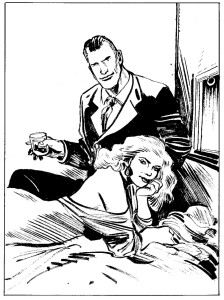
- The Chinese Connection: xenophobia, fears and drugs
Nonetheless, by the time of the Second World War there are negative images of drug users to be detected in Dutch public media, especially if we look at the ‘hidden discourses’ we mentioned above. A good example is Dick Bos, a popular pulp comic series. The first five parts were published in instalments in weekly papers in the years 1940-1942. Dick Bos is a detective who is an expert in an Asian fighting art (jiu jutsu). In his first appearance he is immediately caught up in a drug case. Bos gets on the trail of a gang smuggling cocaine on a Chinese ship. When the gang captures him he is send to China and put to work as slave on a plantation. Of course he escapes and ultimately helps to capture the gang.
That the actual relationship between cocaine and China was a little more complicated does not matter here: many (young) readers of the comic would have become firmly convinced of the connection. In the follow-up story Bos again battles with a gang of drug smugglers, in this case dealing in opium. In part 12, ‘De blauwe diamant’ (The Blue Diamond) cocaine is again of central importance. The gang dealing the drug recruits its clients through the wife of a psychiatrist who needs the money. She peddles the drug among the patients of her husband.
In Dick Bos opium and cocaine are clearly and visual associated with a dark underworld, low-life taverns, unreliable Chinese, and harbours. At the same time the drug trade reaches into the most respectable circles. It is interesting that users are never cool, in the way Sherlock Holmes could be depicted as an addict but still cool. They are psychiatric patients and clubbers that compare poorly to the sober Dutch hero Dick Bos.
But why is there an emphasis on the Chinese connections? Did writer Alfred Mazure only follow American examples (Dick Tracy etc.)? Although these influence were important, the Chinese connection shows how the construction of images of drugs was closely related to global development in the Dutch empire that ruled over Chinese population groups in present-day Indonesia, Suriname… and the Netherlands itself.
From the first arrival of Chinese immigrants in the Netherlands shortly before the First World War they were surrounded with negative images. Part of this had to do with the fact that the first generation was imported by the big Dutch steamship companies in 1911 to work as sailors, mostly as stokers. In this way the companies tried to break the power of the trade unions. This did not make the Chinese popular among the Dutch labour class. In 1927 around 3,000 Chinese were employed on the Dutch transport and mercantile fleet. In the towns of Amsterdam and Rotterdam small ‘China towns’ came into existence. The studies of De Kort and others have shown how the Dutch police and other authorities from the 1920s onwards produced images associating these China towns with drug use, gangs and criminal behaviour. The steamships on which the Chinese worked were seen as an important means of transport for drugs smuggling rings.
5. The Chinese connection in the daily press
To what extent are the images and associations around drugs and drug users in Dick Bos representative for perceptions, opinions and sentiments among the general public in the interwar period? Is there anything characteristically Dutch about these images? Do we find these images before the start of drug legislation in 1920, or even before 1909, the year of the Shanghai conference? In short, when make Chinese opium gangs or addicted nervous patients their appearance in the Dutch public imagination?
We are researching this question by using the data in the Historische Kranten (Historical Newspapers) database of the Royal Library of the Netherlands in The Hague. The aim of this database, that is freely accessible to users through the Internet, is to give a representative selection of digitalized newspapers from all parts of the Dutch empire since 1618. Digitalization is still in process, but in the course of this year the database should contain around nine million pages of newspapers. By doing full-text searches researchers can dispend with more traditional ways of doing newspaper research, such as sample or backbone studies. To us, this is of special importance since we attempt to find the ‘hidden discourses’ next to the explicit discourses and debates that are easier to find with traditional methods ‘by hand’.
To facilitate complex searches and analysis including text mining and sentiment mining we are currently using a web application that we are developing at the Descartes Centre for the History and Philosophy of the Sciences and the Humanities at Utrecht University, in collaboration with the Department of Computer Sciences at the University of Amsterdam (Fons Laan and Daan Odijk): WAHSP (Web Application for Historical Sentiment mining in Public media). This application should become available as an open-source program. Though the development is still in its infancy we can use it to make quantitative analyses as an added tool to the more qualitative analyses of individual documents, of the kind that we did with the Dick Bos comics and other sources. In this way we can make evaluations of the extent to which images as in Dick Bos were representative for the interwar period, or be attended to the existence of images we would not have expected.
We can give here some examples of our preliminary findings, with the caveat that both the Historische Kranten database and the WAHSP application are still uncompleted when writing this paper. We take a look at associations with the drugs that were the target of the Opium Law of 1919: opium, morphine, heroine and cocaine. We will split these associations in four time periods: (I) before the The Hague conference of 1912; (II) from 1912 to the enforcement of the Opium Law in 1920; (III) between 1920 and 1928 when the law was changed making possession an offense; (IV) and from 1928 until the Second World War, when people presumably had other things to worry about.
What is significant is that after 1920 the associations around drugs seem to change. The generic term drugs, which in present-day Dutch is in general use to describe illicit recreational drugs (but not pharmaceutical drugs in medical use), did not exist yet in the Dutch language of the interwar period. The terms used were narcotica, or verdovende or verdoovende middelen (all meaning ‘narcotics’). Before 1920 most uses of these words in the newspapers referred to opium or to chloroform, that had an important role as a narcotic in medicine. But the number of articles dealing with these narcotics is very limited compared to the periods 1920-1928 and 1928-1940. After 1920 the number multiplies with a factor 16. The associations change as well: from ‘medicines’, ‘poisons’, ‘science’, ‘pharmacies’, ‘sleep’ or ‘narcosis’ to ‘police’, ‘contraband trade’, ‘arrested’, ‘confiscated’.
Not only are there increasing associations of the generic term with crime, the same holds for the individual drugs: opium, morphine, heroine, and cocaine. And significantly opium is very much associated with Chinese, China, or with the Dutch East Indies. Even ‘Opiumregie’, the opium distribution and control regime of the colonial state in the Dutch East Indies, is in the first place associated with Chinese (and pathetic) users, and with Chinese crime syndicates that try to evade the Opiumregie by smuggling illicit opiates into the East Indies: smoked opium of a different quality than the standard government issue, and in the 1930s morphine and heroine. Though the number of users stagnates, the need for something stronger seems to be growing.
Apart from the Chinese connection there are some problems with indigenous users in the Netherlands itself. The story line from The Blue Diamond, in which Dick Bos exposed the wife of the psychiatrist as an accomplice of cocaine dealers, turns out to be based on a real life newspaper story. But in a general comparison, the problems with Dutch users are extremely limited. Illicit trade is, as earlier studies had already concluded, in the first place transit trade through the Dutch harbours into other countries.
6. Conclusion
As a preliminary conclusion our analyses place the construction of a drug problem in the Netherlands in the period after the introduction of the prohibitive Opium Law, and connect it clearly not as since the 1960s with a youth problem, but with China and the Chinese. The drug problem is then a problem of empire, or rather: it is not a problem of empire, because since most users are expected to be Chinese or at least non-Dutch, their use could be tolerated or controlled with an Opiumregie, and stricter policies on the American model were unnecessary in the eyes of public opinion.
From pharmaceutical companies to criminal networks
This is the title of my own research project in the NWO sponsored research program The Imperative of Regulation: Local and (trans-)national dynamics of drug regulatory regimes in the Netherlands since the Second World War. I will be starting on 1 October as a research fellow at the history and philosophy of science section at the Faculty of Science, Utrecht University (Freudenthal Institute, whose director Toine Pieters is also a director of the research program).
The idea is to cover the tremendous changes in the supply-side of the psychoactive drug market, from the looted stocks of the German Wehrmacht and the limited supplies of the pharmaceutical companies in 1945 to the shift to an Internet based market in illicit drugs 70 years later. In this period the Netherlands continued its century-old tradition as a major producer, transporter and consumer of psychoactive drugs. We are not only focusing on illegal drugs in this project, but also on the shifts and transitions between legal and illegal use, and between ‘street’ drugs and drugs on medical prescription.
Interestingly, on today’s digital silk roads both are sold without government control and even with a libertarian or anarcho-capitalist justification. According to an interesting essay by American political scientist Henry Farrell this attempt to create control-free drug markets (at least, without control by the state) has only led to other forms of regulation, including the ultimate enforcing mechanism of all control: violence. ‘The Silk Road might have started as a libertarian experiment, but it was doomed to end as a fiefdom run by pirate kings’, Farrell writes.
The whole idea of a control-free drug market is of course a historical fiction and unravelling the historical dynamics underlying patterns and mechanisms of evolving drug markets will be a major aim of my project. 
